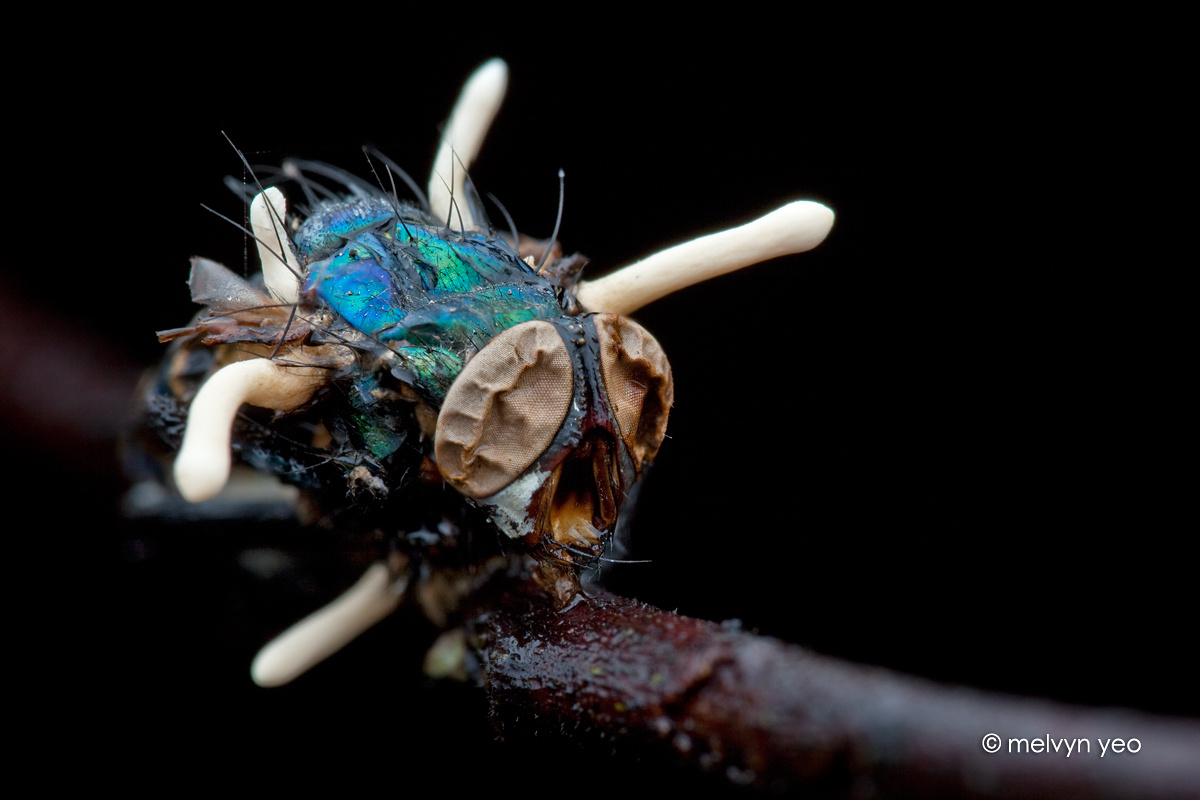ShopDreamUp AI ArtDreamUp
Deviation Actions
Description
A fly fallen to a Cordyceps fungi.
Taken at night in Singapore.
Quote from en.wikipedia.org/wiki/Cordycep…
Cordyceps /ˈkɔrdəsɛps/ is a genus of ascomycete fungi (sac fungi) that includes about 400 species. All Cordyceps species are endoparasitoids, parasitic mainly on insects and other arthropods (they are thus entomopathogenic fungi); a few are parasitic on other fungi. Until recently, the best known species of the genus was Cordyceps sinensis,[1] first recorded as yartsa gunbu in Tibet in the 15th century[2] and known as yarsha gumba in Nepali and "caterpillar fungus" in English. In 2007, nuclear DNA sampling revealed this species to be unrelated to most of the rest of the genus' members; as a result it was renamed Ophiocordyceps sinensis and placed in a new family, the Ophiocordycipitaceae.
The generic name Cordyceps is derived from the Latin words cord, meaning "club", and ceps, meaning "head". Several species of Cordyceps are considered to be medicinal mushrooms in classical Asian pharmacologies, such as that of traditional Chinese[3][unreliable source?] and Tibetan medicines.
When a Cordyceps fungus attacks a host, the mycelium invades and eventually replaces the host tissue, while the elongated fruit body (ascocarp) may be cylindrical, branched, or of complex shape. The ascocarp bears many small, flask-shaped perithecia containing asci. These, in turn, contain thread-like ascospores, which usually break into fragments and are presumably infective. Some current and former Cordyceps species are able to affect the behaviour of their insect host: Ophiocordyceps unilateralis (formerly Cordyceps unilateralis) causes ants to climb a plant and attach there before they die. This ensures the parasite's environment is at an optimal temperature and humidity, and that maximal distribution of the spores from the fruit body that sprouts out of the dead insect is achieved.[4] Marks have been found on fossilised leaves that suggest this ability to modify the host's behaviour evolved more than 48 million years ago.[5]
The genus has a worldwide distribution and most of the approximately 400 species[6] have been described from Asia (notably Nepal, China, Japan, Bhutan, Korea, Vietnam, and Thailand). Cordyceps species are particularly abundant and diverse in humid temperate and tropical forests.
Some Cordyceps species are sources of biochemicals with interesting biological and pharmacological properties,[7] like cordycepin; the anamorph of Cordyceps subsessilis (Tolypocladium inflatum) was the source of ciclosporin—a drug helpful in human organ transplants, as it suppresses the immune system (immunosuppressive drug).
Taken at night in Singapore.
Quote from en.wikipedia.org/wiki/Cordycep…
Cordyceps /ˈkɔrdəsɛps/ is a genus of ascomycete fungi (sac fungi) that includes about 400 species. All Cordyceps species are endoparasitoids, parasitic mainly on insects and other arthropods (they are thus entomopathogenic fungi); a few are parasitic on other fungi. Until recently, the best known species of the genus was Cordyceps sinensis,[1] first recorded as yartsa gunbu in Tibet in the 15th century[2] and known as yarsha gumba in Nepali and "caterpillar fungus" in English. In 2007, nuclear DNA sampling revealed this species to be unrelated to most of the rest of the genus' members; as a result it was renamed Ophiocordyceps sinensis and placed in a new family, the Ophiocordycipitaceae.
The generic name Cordyceps is derived from the Latin words cord, meaning "club", and ceps, meaning "head". Several species of Cordyceps are considered to be medicinal mushrooms in classical Asian pharmacologies, such as that of traditional Chinese[3][unreliable source?] and Tibetan medicines.
When a Cordyceps fungus attacks a host, the mycelium invades and eventually replaces the host tissue, while the elongated fruit body (ascocarp) may be cylindrical, branched, or of complex shape. The ascocarp bears many small, flask-shaped perithecia containing asci. These, in turn, contain thread-like ascospores, which usually break into fragments and are presumably infective. Some current and former Cordyceps species are able to affect the behaviour of their insect host: Ophiocordyceps unilateralis (formerly Cordyceps unilateralis) causes ants to climb a plant and attach there before they die. This ensures the parasite's environment is at an optimal temperature and humidity, and that maximal distribution of the spores from the fruit body that sprouts out of the dead insect is achieved.[4] Marks have been found on fossilised leaves that suggest this ability to modify the host's behaviour evolved more than 48 million years ago.[5]
The genus has a worldwide distribution and most of the approximately 400 species[6] have been described from Asia (notably Nepal, China, Japan, Bhutan, Korea, Vietnam, and Thailand). Cordyceps species are particularly abundant and diverse in humid temperate and tropical forests.
Some Cordyceps species are sources of biochemicals with interesting biological and pharmacological properties,[7] like cordycepin; the anamorph of Cordyceps subsessilis (Tolypocladium inflatum) was the source of ciclosporin—a drug helpful in human organ transplants, as it suppresses the immune system (immunosuppressive drug).
Image size
1200x800px 424 KB
Make
Canon
Model
Canon EOS 5D Mark II
Shutter Speed
1/160 second
Aperture
F/16.0
Focal Length
100 mm
ISO Speed
200
Date Taken
Oct 22, 2014, 2:11:17 AM
Sensor Size
7mm
© 2014 - 2024 melvynyeo
Comments39
Join the community to add your comment. Already a deviant? Log In
And suddenl I am sorry for a fly. Rest in ... ah,... well, Rest in the sky.

































